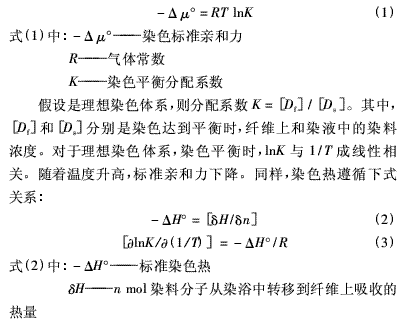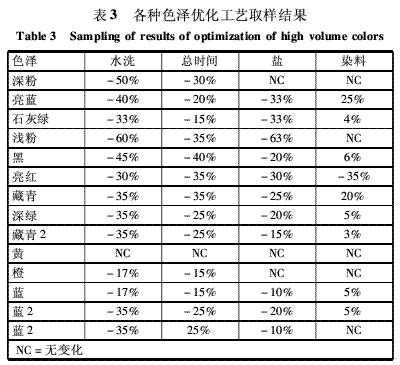Real-time control of reactive dyeing Chen Ying Translated by Xie Yi School
Excerpted from the American Review of American Textile Chemists and Dyers Association
Reactive dye dyeing requires a large amount of water, salt and alkali, and at the same time produces a hydrolyzed dye, and thus is considered to be the least utilized dye, and its aquatic toxicity and colored pollution are major problems. Through real-time analysis, you can optimize the dyeing and washing process of any color to get the best dyeing effect. The so-called process optimization, that is, in the shortest time, the process is completed with the least amount of water, salt, dyes, additives and energy. The implementation of process optimization can achieve the sustainability of reactive dye cotton dyeing. This article describes an example of cotton reactive dyeing process optimization.
Equipment HueMetrix Dye-it-Right real-time monitoring system, JFO Lab Jet (WarnerMathis). The dye bath circulates in the sampling cell between the JFO and the monitor. Every 90 s, the monitoring system samples from the sampling pool for analysis.
Test Methods The dyed fabrics are supplied by the customer and are 100% cylindrical cotton knits that have been scoured or bleached depending on the color. Each color was monitored twice in the original formulation and process to ensure accuracy as the raw material for analysis. A complete set of dyeing and washing processes is used as the source material. The calibration equipment was calibrated by injecting 5 calibration solutions into each dye solution. The pattern was cut into 1 100 g per serving, placed in a JFO dyeing machine, and washed with warm water and drained.
The analytical balance weighs the dye. After distilling the hydrate, it is dissolved in water at 140 °F. The dye bath ratio is 8:1. When the dye is added, the monitor is started. The dye is tested after it is placed in the machine to ensure that the initial concentration reaches the process setting. Due to the limitations of the JFO equipment, only the discharge-injection type water washing can be performed, and the overflow water washing cannot be performed. The data and charts required to optimize the process are delivered to the user via advanced data analysis equipment.
Case 1: Dyeing of dark black refined cotton fabric The original formula of Case 1 is shown in Table 1. Figure 1 shows the dyeing of the original formulation and the optimized formulation and process. 
For the deep black color in this case, reducing the amount of salt and alkali will reduce the fixing rate of the dye, but the reduction in the amount of salt will increase the washing efficiency. This is because the reduction in the amount of salt reduces the affinity of the hydrolyzed dye. On the other hand, a decrease in the amount of salt will also result in a decrease in the exhaustion rate. This is easily seen by the monitoring system. Although reducing the amount of salt will reduce the exhaustion rate, it is known from thermodynamic analysis how to maintain the exhaustion rate at a similar level, especially in the early stage of dyeing. The standard affinity of the dye is shown in formula (1): 
In an ideal dyeing system, -ΔH° is a negative value, so the dye-dyed fiber is an exothermic process. Formula (3) shows that, at elevated temperatures, the dye tends to remain in the dyebath (low dye uptake); lowering the temperature favors dye-dyed fibers (high dye uptake). From this, the relationship between temperature and dye uptake can be found. When dyeing dark black, to reduce the amount of salt, the initial dyeing temperature can be reduced from 60 ° C to 45 ° C, the dye affinity for fiber is improved, the effect caused by the decrease of salt dosage is compensated, and the dyeing rate is in the original formula. The 100 g/L salt mass concentration is comparable. Understanding the effects of pH, bath ratio, auxiliaries, and dyeing equipment can help improve the directness of the dye to the fiber.
In the optimization of the dark black dyeing process, the water washing process is basically the same as the original process except that a water washing process is omitted. In this way, the overall process time is reduced by 15%, the amount of salt is reduced by 20%, the amount of dye is increased by 3%, and the washing by 10% is reduced.
Case 2: Bleached cotton knit fabric navy staining The staining data for this case is shown in Figure 2. 
The real-time monitoring data of the water bath in Figure 2 shows that it is also possible to reduce the amount of water used for washing.
Figure 3 is the dye concentration in a navy blue water bath. 4 times and 5 times of washing, the difference in dye concentration in the bath is very small. The dye is less than 0.009 g/L, which is obtained without adjusting the dyed fresh water usage, time and energy according to improving dye fastness and reducing waste water pollution. According to experience, when the mass concentration of each dye in the washing liquid drops to (0.005±0.002) g/L, and the cumulative amount reaches (0.015±0.002) g/L, the dyeing worker can further reduce the dyeing. The number of washes. 
For the navy blue in this case, two water washing processes were omitted, and the salt mass concentration was reduced from 45 g/L to 40 g/L, and the time was shortened by 15%. In the optimized process, the temperature was maintained at 60 °C. After the salt consumption is reduced, the initial dye uptake rate is 8% lower than the original process. The fixing rate is slightly lower than the standard process. Since the yellow and red dyes are used in a small amount, the reduction in the fixing rate is not remarkable. From a cost perspective, it is more advantageous to reduce the amount of salt and slightly increase the amount of dye used. Another benefit of reducing the amount of salt used is that less water is removed by water washing and the washing efficiency of the hydrolyzed dye is higher. In fact, the reduction in salt usage and the increase in dye usage reduce the number of washes (Table 3). The ΔECMC of the optimized process and the standard dyeing process is 0.56 and the color intensity is up to 96.2%.
Case 3: Bleached cotton knit fabric brown-green dyeing Primary quasi-dyeing is an important factor for sustainable development and can solve the problem of reactive dye dye reproducibility. Rickets in production (such as poor leveling) can be solved by heavy dyeing, but are inefficient and wasteful for dyeing plants and the environment. This case simulates a small bath ratio (6:1) jet dyeing machine, and the dyed cotton knit fabric is poorly leveled. The navy blue dyeing in the original dyeing process is extremely fast, and the peak rate exceeds 4%/min. The optimization process uses batchwise addition of alkaline agents (1/10, 2/10, 3/10 and 4/10) in the same time, and the maximum dyeing rate of navy blue is nearly halved. There is no doubt that this can alleviate the problem of levelness. The dye uptake rate and dye uptake rate of the two processes are shown in Figures 4 and 5. 
It can be seen from Fig. 4 and Fig. 5 that the batch dyeing rate is almost half of the original process (from 4%/min to 2.25%/min) and the peak is broadened. This means that the dye is slower to dye and the dyeing effect is more uniform. It is worth noting that completing the process does not extend the process time.
It can be seen from Table 3 that after real-time monitoring and optimization of the process, the cotton reactive dyeing has a large space for saving operating costs and environmental costs. For light colors, the increase in the amount of 10% dye is negligible, and the benefit of a 10% reduction in salt/alkali is indeed considerable. 
The formal name of quincunx screw is iso10664 screw or hexagonal internal, also known as star socket screw. It is a kind of screw fastener developed and listed by camcar Textron in 1967. Because the trade name that Kangjia applied for a patent in that year was "X", it was also called "x screw". Quincunx screw is widely used in brake system, hard disk, computer system and consumer electronic products of automobiles, motorcycles and bicycles.
Torx Screws,Din7985 Torx Screws,Stainless Steel Torx Screws,Torx Screws Security Stainless Steel
Suzhou Gubao Screws Co.,Ltd. , https://www.gbscrewes.com